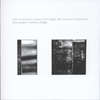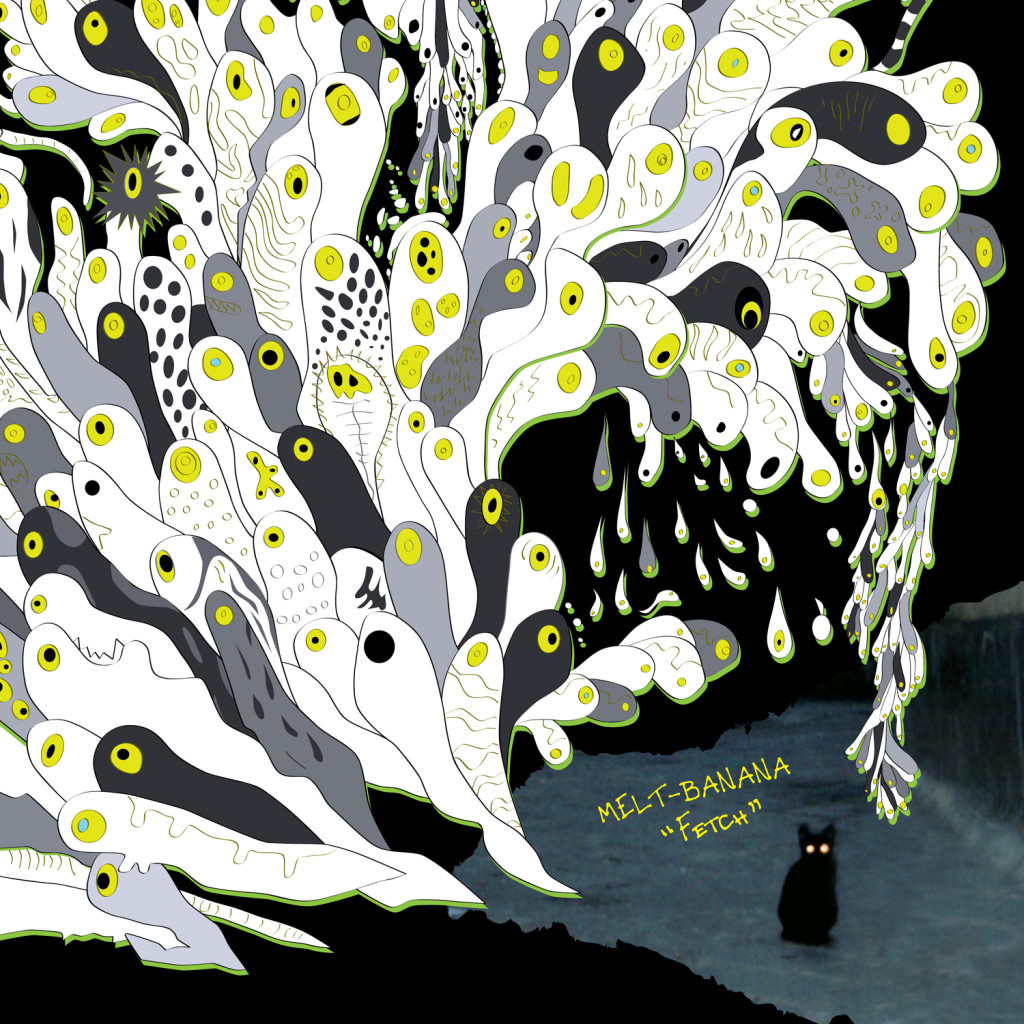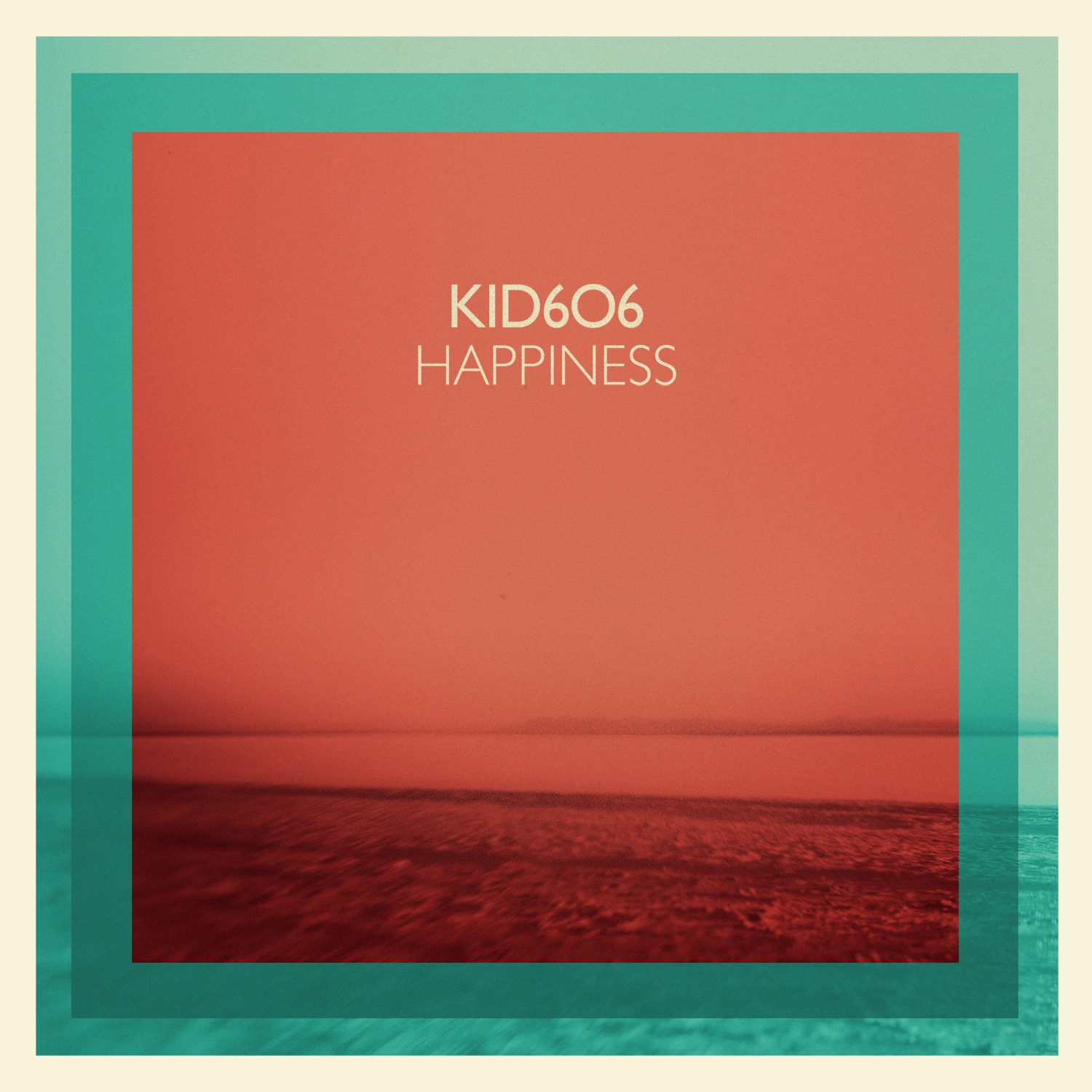- Administrator
- Albums and Singles

Chondritic Sound label head Greh Holger initially began work as a harsh noise artist, but like many in that field, his tastes and art has changed and evolved, and on this pair of new releases that is completely evident. With both his synth pop project Pure Ground becoming a tighter band and his solo noise guise Hive Mind displaying even greater compositional tactics, he is definitely at the top of his game.
Pure Ground, which is Holger with Jesse Short, has only produced two EPs (this being the second), and a 7 inch single thus far, but even with that limited discography the duo are honing their craft rather quickly.Rather than being simply a showcase for vintage electronic instrumentation, like many in the minimal wave revival scene, "Atlantic Wall" is truly a hook laden aggressive pop song.The bass line that shifts from a catchy melody to a curt thump pairs perfectly with the snappy drum machine beat and noisy synth lead.The verse/chorus/verse structure is rather simplistic, but in the way that all good pop songs should, and leads to a memorable chorus that is extremely memorable.
The three remaining songs are just as good, but not in the same infectious way.The taut bass and shimmering synth pads of "From Outside" and serpentine lead and buried vocals of "With the Old Ways" are great in their own right, however, even if they do not have quite the same earworm quality.Pure Ground go darker and more dissonant on the closing piece, "Sacrificed to Purpose," which is more dissonant than the preceding with its immediate machinery pounding beat.With a shrill lead and everything bathed in liberal layers of reverb, it embraces texture more than hooks, and excels at its goal while making a fitting tribute to mid 1980s industrial.
 Hive Mind does not focus as much on rhythm and musicality on Beneath Triangle and Crescent, but they express more structure than previous, harsh noise focused works.The crackling noise and low end push of "Exodus" initially feels in league with the European school of power electronics, but soon changes.As a subtle hint of melodic synth throb begins to become prominent, the noise becomes darker and more oppressive before retreating.The remaining dissonance and depressive electronic melody feels more akin to Maurizio Bianchi's earlier work than it does that of Genocide Organ or the like.
Hive Mind does not focus as much on rhythm and musicality on Beneath Triangle and Crescent, but they express more structure than previous, harsh noise focused works.The crackling noise and low end push of "Exodus" initially feels in league with the European school of power electronics, but soon changes.As a subtle hint of melodic synth throb begins to become prominent, the noise becomes darker and more oppressive before retreating.The remaining dissonance and depressive electronic melody feels more akin to Maurizio Bianchi's earlier work than it does that of Genocide Organ or the like.
"Detritus" features a similar combination of melody and noise, with the former being more bleak and the latter harsher.Jagged, harsh sheets of distorted squeal crash and eventually take the piece back to the harsh noise days, but not before resembling an even more tortured, deconstructed version of The Cure’s Pornography.The final, side-long title piece embraces both of the extremes, with its overdriven low end and slow synthesizer sweeps giving it texture and depth.The slow build drifts back into the dour, depressive electronic territory, and keeps the harsher moments at bay for its full duration.
Between the indisputably catchy moments of Protection and depressive noise of Beneath Triangle and Crescent, Holger does not disappoint.Even with the more complex, song-oriented approach to these compositions, there remains that dirty, noisy edge of his earliest work, which goes a long way in giving these two sets of songs character and an identity all their own.
samples:
 
Read More
- Administrator
- Albums and Singles
 Vitiello and Berg have collaborated before on 2009's The Gorilla Variations. Like that work, the two improvise together, Vitiello primarily on guitar and Berg on clarinet and vocals. However, due to heavy amounts of processing and editing, only a ghost of untreated instruments shine through, resulting in an album rife with sadness and longing, but never in an overly bleak or depressing way.
Vitiello and Berg have collaborated before on 2009's The Gorilla Variations. Like that work, the two improvise together, Vitiello primarily on guitar and Berg on clarinet and vocals. However, due to heavy amounts of processing and editing, only a ghost of untreated instruments shine through, resulting in an album rife with sadness and longing, but never in an overly bleak or depressing way.
The moments where the core instruments can be identified are relatively far between on this album:"From Here" demonstrates some of the more overt acoustic guitar that can be heard, while "Back Again" features it only in fragmented sputters and shards. Clarinet feature prominently on "Clarinet Assembly" (unsurprisingly), accompanied by a skittering rhythm that sounds as if it were constructed from a malfunctioning guitar cable.
It is on pieces such as "Voice L-," where the instrumentation is almost impossible to discern other than Berg's vocals, leading to the album’s most enigmatic moments.What sounds like a basic repeating synthesizer sequence underscores breathy, hushed moments of voice.With the added rhythmic heartbeat-like accompaniment the piece is filled out nicely, and overall conveys an intimate, home taped like sound to it."Easy Travel" may also have some noticeable guitar, but the strength of it is due to the bassy low end textures and occasional outbursts of unidentifiable noise that overshadow the more identifiable moments.
Closing piece "Another End" may be the most significantly different sounding song to be heard here.Recorded separately from the other nine compositions that make up the album, there is less of that analog tape fuzz home recording sensibility and instead a cleaner, richer sounding mix.Hushed voices and quiet clarinet bits lay atop changing and evolving electronics and effects.It definitely fits in with the rest of the disc, but its cleaner ambience signals a colder, sadder end to the album.
Two of these ten songs are actually the work of a trio, with the addition of renowned violinist Hahn Rowe.On "Recap (With Violin)," his contributions are most blatant; producing dry, almost painful string scrapes that make for a shrill, dissonant experience while still retaining a haunting sense of melodicism.His other appearance is on the aforementioned "From Here," where his playing is kept to low key string plucks and pensive accents that blend beautifully into the other instruments.
If there is a weakness to this album as a whole, it would be the moments where it simply feels as if it is a collage of random sounds rather than an actual album.These moments are fleeting, and definitely do not overshadow the more cohesive elements, nor do they weigh particularly heavy in any one song.To some extent this is expected though, given the nature of how these songs were recorded (improvised with little or no discussion between the players beforehand). Aside from that small negative, Between You And the Shapes You Take is a beautifully melancholy, intimate piece of mystery and intrigue.
samples:
 
Read More
- Administrator
- Albums and Singles

An album presented in two distinct movements, one on each side of the LP, Olivia Block's latest work at first seems like two diametrically opposed pieces, but are thematically, if not evidently from the sound, tied to one another. Based partially on the idea of presentation, both in the form of musical performance and in the sociological perception of the self, Karren has conceptual depth, but is captivating even stripped of that fact.
The A side composition, "Foramen Magnum," is the darker and more discordant of the two by far.Culled from field recordings in a multitude of public locations, such as zoos and museums from across the world, as well as orchestral rehearsals (of the piece that lies on the other side of the LP), there is a chaotic, disjointed quality throughout.Unidentifiable found sounds, crispy processed static and a menacing far off hum sets a sinister tone at the onset.
The occasionally overt smattering of applause, fragmented conversation or obvious sound of footsteps makes for a precious few moments of familiarity, but the rest is disconnected and improvised feeling.It continues to move and evolve for its 20 minute duration, never really fully settling into a single mood or sound until the conclusion.
With "Foramen Magnum" acting as the back stage half, "Opening Night" is the on stage piece.Performed by the Chicago Composers Orchestra, it is a much more calming and meditative piece.Recorded over a period of multiple years and with added percussion courtesy of Jon Mueller, it results in a soaring piece of layered strings and organic sounds.Linked together, the result is more that of a mass of instruments than anything overly identifiable.
Even in this fog, an individual instrument sometimes floats to the surface only to be pulled back again into the mass.Throughout there is a slow, aquatic like flow that moves the composition forward, with sporadic, unobtrusive bits of percussion, but nothing that upsets the soft balance.Towards the end, the instruments seem to lose their identifiable qualities and instead take a turn for the synthetic and almost unnatural, closing in a very different way than it began.
Concepts aside, Karren makes for a distinctly bipolar pairing of compositional styles, with "Foramen Magnum" emphasizing the rawer, more electro-acoustic elements of Olivia Block's work, while "Opening Night" is rooted more in traditional sounds and structures.Neither feel rigidly rooted in their respective styles, however, and some bleed over does occur, reflecting Block's own self as a distinct and proficient composer.
samples:
 
Read More
- Administrator
- Albums and Singles
 The Stranger’s second album sounds very different from his 2008 release Bleaklow. Whereas that debut was doused with a sense of trekking over ancient stones and moors of Northern England, this record feels much more interior, claustrophobic and urban. The rhythms boom and snake through a threatening, shattered, dystopia like rats crawling through pipes beneath a recently evacuated building.
The Stranger’s second album sounds very different from his 2008 release Bleaklow. Whereas that debut was doused with a sense of trekking over ancient stones and moors of Northern England, this record feels much more interior, claustrophobic and urban. The rhythms boom and snake through a threatening, shattered, dystopia like rats crawling through pipes beneath a recently evacuated building.
James Leyland Kirby* has created myriad projects, spanning the mysterious and the ludicrous, over the past two decades, and The Stranger is arguably the least known of his album-length ventures. This second release shares, most evidently on "Providence or Fate," a little of the melancholy, ghostly beauty, if none of the treated vocals, associated with his best loved guise, The Caretaker. That piece and the following one, "Where Are Our Monsters Now, Where Are Our Friends?," are the treasure at the core of this album, the latter developing with an almost Canterburyesque synthesizer line weaving back and forth. I say synthesizer, but the elements and method of constructing these tracks is far from obvious.
Here and there it may be possible to suggest some leftover vinyl crackle has been borrowed; this clang may be a spanner whacking a burned out car; that stretched, spiraling, sound—on "Spiral of Decline"—might be a ball-bearing falling down a series of drainpipes; that could be a re-wired drum machine; or field recordings of a scrapyard documented on an old answering machine. Generally it is all rather enjoyably baffling and quite a progression.
Watching Dead Empires In Decay resembles a concept album wherein warring factions find themselves survivors of a devastating incident, after which taking sides matters less than just getting by in a landscape of architectural ruin, with pissed-in elevators, downed power lines and stench-filled underground tunnels. P.D.James’ The Children of Men came to my mind, among other narratives. It is an unexpected and excellent development of The Stranger’s sound. However, a protagonist residing in Watching Dead Empires In Decay would probably welcome a break among the traces of unpleasant memories and the harsh yet comfortingly unchanging terrain of Bleaklow.
*Hopefully he resurrects the brilliantly lascivious character of The Colonel to update another unhealthy dose of his highly salacious ode "Cup, my balls" in time for the 2014 FIFA World Cup tournament in Brazil.
 
 
Read More
- Administrator
- Albums and Singles
 An entire album's worth of field recordings can be a daunting proposition. As an added instrument, they often are mixed into other albums all the time to great effect, but the idea of a full album of nothing else can be intimidating, unless it involves Chris Watson.  However, this five artist/one track performance works splendidly, emphasizing the varying elements of the genre and staying compelling throughout its nearly 18 minute duration.
An entire album's worth of field recordings can be a daunting proposition. As an added instrument, they often are mixed into other albums all the time to great effect, but the idea of a full album of nothing else can be intimidating, unless it involves Chris Watson.  However, this five artist/one track performance works splendidly, emphasizing the varying elements of the genre and staying compelling throughout its nearly 18 minute duration.
In the text that accompanies, which includes one piece from each artist, it's Seth Cluett’s passage that resonates with me the most.His discussion of how field recordings are catalysts for memories is definitely understandable, but they also inspire the imagination.Traditional music entertains, but it doesn’t create visualizations and speculation on how it was recorded like this sort of work does.
For this project, each artist contributed ten minutes of field recordings, with no post production, that are weaved together into a single piece.Admittedly, these aren't seamless transitions:it's pretty easy to tell where one ends and the next begins, but that also helps to emphasize each artist's unique contributions.
For example, the first segment by Scott Smallwood is an obvious recording of water running from a faucet, yet accompanied by a singular dripping sound that mimics a basic, but perceptible rhythm to give a musical counterpoint to the otherwise abstract sounds.Later on a passage of wind chimes serves a similar purpose, putting melodies in amidst the dissonance.
Seth Cluett's contribution also mixes in more traditional "music" moments, with distant bells that, panned and far enough off, sound much more like studio creations than they actually are.Sawako goes for a different facet of field recording:by capturing fragments of ghostly conversations and howling winds, an almost alien landscape is conjured, with only bits of familiarity to be recognized.
The final two pieces, courtesy of Ben Owen and Civyiu Kkliu, opt to use recordings in a completely removed, utterly abstract context.Owen's segment of distant thuds and bangs could be anything, and his later inclusion of lovely, quiet static solidified its greatness for me.Kkliu’s closer sounds like a dying PC power supply, amplified to absurd levels, and some electronic interference/breakdowns thrown in to liven things up and end the work on a noisy note.
The easy criticism to level at artists in this field is that they are not actually "creating" but just "capturing" the world, and I’m sure for some that’s a fair critique, but it does not apply here.None of these recordings sound accidental or haphazard, instead they sound like the result of careful planning and deliberate microphone placement.Whether it's creating tangible visual environments via audio, mutating the known into the unknown, or using everyday sounds to create widely diverging textures, it's all included within this album.
samples:
 
Read More
- Administrator
- Albums and Singles
 A six year absence means nothing to Melt-Banana. Fetch is a minor refinement of past efforts in the band's 20 year career, unraveling over a bevy of short, aggressive songs to reveal itself as either an irreverently noisy pop album, or an intermittently poppy noise rock album, depending on your point of view. They have a knack for straddling the fence between kitsch and the vaguely obscene, and that grey area has never seemed so lived-in and comfortable as on their newest work.
A six year absence means nothing to Melt-Banana. Fetch is a minor refinement of past efforts in the band's 20 year career, unraveling over a bevy of short, aggressive songs to reveal itself as either an irreverently noisy pop album, or an intermittently poppy noise rock album, depending on your point of view. They have a knack for straddling the fence between kitsch and the vaguely obscene, and that grey area has never seemed so lived-in and comfortable as on their newest work.
The departure of Rika Hamamoto has served to further focus the distinct, poppy sound that became Melt-Banana's M.O. on Bambi's Dilemma and hinted at in past releases. At this point, all non-guitars and non-voices serve a streamlined, utilitarian purpose, aiding the lead instrumentation in overwhelming the senses. The hi-fi, crystalline mastering adds to the controlled chaos, filling the midrange to the point of aural fatigue. Yasuko Onuki's inimitable bubblegum-and-glass cadence has usually been the most difficult barrier to entry in enjoying Melt-Banana's brand of splintered noise rock. As Melt-Banana's grindcore edges were slowly whittled down and sanded smooth, though, Onuki learned to cut loose more, to care less, and to sing with a more confident, punky sourness which complimented the depreciation of the band's formerly caustic and incalculable melodies. Similarly, the guitar work of Ichirou Agata has grown conciser and more smartly composed; clear chords ringing through on choruses where before there was only hissing, ear-splitting saturation. The cacophonous pedal abuse has mostly been pruned down to staccato loops and the occasional laser gun blast.
Songs like "Candy Gun," "The Hive," "Lie Lied Lies," and the closer "Zero" are all instant classics as a product of this massively increased attention to detail. They are sharp without being impossible to like, and easily some of the catchiest material the band has worked with. Waylaid prior by extraneous band members, perhaps, this newest effort keeps a stranglehold on one idea and makes a killer argument for total musical tunnel vision, with a success rate that can sometimes seem to paint a lot of their past work as too cluttered. If that seems blasphemous, I am surprised too. Nothing overstays its welcome here. Even odd song out "Zero+" sells as an interlude, a glitched guitar cycling through accidental melodies before resolving in froggy silence.
In essence, Fetch is a gleeful embrace of the band's innate kitsch, which always lay under its surface. In past albums, it was an inversion of the trope: a rock band jokingly dangling its own freakish clone of pop cheer above the noise. Now Fetch finds them in contrast, having traversed the harsh end of the spectrum, finding there might be a way to write more accessibly without resorting to self-censoring their best qualities. A song or two flirts with thrash and some of noise pop's dancier excursions, occasionally at the expense of the reckless exuberance of earlier releases, but it is still one of the least commercial releases likely to be given coverage by more well-known publications. Jaded fans clamoring for a now uncharacteristic shift to the old familiar chaos have had about a decade to adjust, and if the biggest complaint to be leveraged against the band is that after two decades they have gotten a little more focused, they have nothing to worry about.
Samples:
Read More
- Administrator
- Albums and Singles
 Kid606 has never quite fit into a particular narrative as an artist, which I have always felt was the strongest attribute to surviving as an electronic producer in the flooded market of similarly supertalented electronic producers. Equally brooding, romantic, humored, and flat-out destructive, Miguel De Pedro makes no effort to coordinate releases, or to eschew the fleeting moods and odd moments that fill any life of a grown adult and derive inspiration from any and all of them. Happiness is another one of his "heart on sleeve" albums, full of airy downtempo compositions similar to P.S. I Love You or Resilience, which means that fans of the softer end of his catalog will probably love it and fans of hyperactive scene destroying genius nonsense (myself included) will mostly only tolerate it.
Kid606 has never quite fit into a particular narrative as an artist, which I have always felt was the strongest attribute to surviving as an electronic producer in the flooded market of similarly supertalented electronic producers. Equally brooding, romantic, humored, and flat-out destructive, Miguel De Pedro makes no effort to coordinate releases, or to eschew the fleeting moods and odd moments that fill any life of a grown adult and derive inspiration from any and all of them. Happiness is another one of his "heart on sleeve" albums, full of airy downtempo compositions similar to P.S. I Love You or Resilience, which means that fans of the softer end of his catalog will probably love it and fans of hyperactive scene destroying genius nonsense (myself included) will mostly only tolerate it.
Happiness comes at the tail end of a lot of personal changes for De Pedro, who has recently relocated to Los Angeles, and much of the press around the album will make note of this. It is not particularly new territory, however; PS I Love You was the most endearing and exquisitely brief of his more emotional excursions, and some of his older songs ("Parenthood," "For When Yr Just Happy To Be Alive") have been demonstrating his knack for simpler, more idyllic compositions since back in the early 2000s. It seems strange to say but a wistful Kid606 is often best handled in small doses; those songs were great because they lay at the opposite end of a barrage of rambunctious breakbeats and appropriated ragga grooves. They stood out because they did not have to be there, because they were an oasis of sincerity and exploration that showed Miguel's emotional and technical range and because there was an implication that something important had to be said, if only briefly. Those softer moments were Kid606's self-therapy in practice; a catharsis for a frustrated artist who sometimes got tired of their own schtick.
There are a number of solid songs on the album that make a good case for it being culled down as an EP. "Coronado Bay Breezin'" basically succeeds where the first three songs on the album fail; a bit of early afternoon beach-drive downtempo with a smart balance of empty space and manipulated effects to undercut the sparseness of the melodies. "Happiness Is A Warm Kitten" and "If I am only allowed one song on the album with cut up female vocals then this song is it" fill the quota for tongue in cheek song titles along with being genuinely pleasant slices of ambient electronica. "Taco Time" and equally alliterative "Tarsier Treehouse" are all too brief highlights as well, all clipped loops of thick fuzz and fake strings fumbling around in processed uncertainty, masquerading as interludes. Happiness does not demonstrate any new range of talents or moods, though. It just reinforces the same things we already knew.
For the most part I can not help but think that as technological improvements and stylistic shifts have settled into a comfortable equilibrium, some of De Pedro's edge as an innovator has suffered for it. He was functioning at his best when he was pushing against the boundaries of how and why music in the scene was being made. No longer moving and changing, Happiness represents little more than a staid devotion to a kind of inoffensive electronica that has always been in need of a serious sea change. This is the last thing to expect from a Kid606 album, so while it is impossible to hate something so aimlessly pretty, it also does not offer enough to grab onto to earn any kind of lasting attention.
Samples:
Read More
- Administrator
- Albums and Singles

Jason Urick's second full-length for Thrill Jockey is an enigmatic and confounding one, as many elements of his laptop-based soundscapes rival the work of higher-profile kindred spirits like Tim Hecker.  However, his ingenious and unconventional production talents are somewhat undercut by a strange obsessiveness (which extends even to the title, as Urick was fixated on Marco Ferreri's 1986 film of the same name while working on the album).  That curious combination makes for a simultaneously striking and uneasy listening experience.
I think Jason Urick must have a lot of the same software as Daniel Lopatin, as I could easily have been convinced that this was a lost Oneohtrix album when I first put it on.  That unavoidable comparison pretty much smacked me in the face as soon as the weirdly warped and shuddering synthesizers (or voices) came in on "I Love You," but on a deeper aesthetic level, Urick is doing something very divergent from Lopatin or anyone else.  That distinction becomes increasingly noticeable as the album progresses: Urick's pieces tend to involve just one or two key samples or motifs that are enthusiastically stretched, slowed, and processed until they sound thoroughly vibrant, ravaged, blurred, and impossibly thick.
That doesn't mean that these five pieces are simple though—they're very dense, ingeniously textured, and complex in their own way.  It's just that Jason tends to focus all of his creative energies on honing his primary themes into something unnaturally immense and distorted—there isn't too much happening into periphery or any apparent interest in space or dynamic variability.  Such a "maximizing minimalism" approach is a very unusual one, but it is not unsuccessful.  There is a great deal of life and depth to Urick's melodies, as he clearly knows how to craft (or appropriate) a solid hook and is not at all shy about tweaking it into woozily quavering otherness. Also, his forceful, tightly structured presentation make his songs immediately accessible, memorable, and heavy.  The resultant downside, however, is that there aren't terribly many secrets or surprises left to discover with repeat listens.
Notably, there's also an element of the perverse or paradoxical to I Love You, as the songs sound futuristic and processed into oblivion, but they're often built upon recognizably traditional samples.  In fact, on "Ageless Isms," it even sounds like he took an old ballad from the Far East in its entirety and just slowed, pitch-shifted, and generally garbled it into utter unrecognizability.  "Don't Digital" seems to achieve similarly impressive levels of chopped-and-screwedness with an accordion and a fiddle.  I could have that completely wrong though, as Urick's manipulation of his source material is so drastic that it could be almost anything (reggae and dub tend to come up quite a bit as possibilities whenever this album is discussed).
Regardless of where he is borrowing from, I find it conceptually amusing: applying cough medicine-fueled hip-hop tactics to traditional Asian music is just as inspired as using dub tactics to shred dub into utter abstraction.  Still, my favorite pieces are the album's more drone-based book-ends: the title piece and "Syndromes" essentially sound like spaced-out ambient synth music muscled-up to a rumbling and shuddering intensity level. Also, the ghostly, warbling sample (koto?) at the end of "Syndromes" might be the single best thing on the album.
Despite all those great attributes, however, I Love You can be a tough listen.  The album's most significant and fundamental flaw manifests itself most strongly with the candy-colored synth psychedelia of "The Crying Song": Urick's music is so dense, busy, over-processed, and over-saturated that it can be absolutely exhausting to listen to in large doses.  There's no space, nothing natural, no breathing room–just an unrelenting, undulating mass of thick synthetic sounds.  That makes this a very difficult album to love, but it is definitely not a hard one to be impressed by: despite its flaws, I Love You is still one of the most full-on, attention-grabbing abstract electronic albums that I have heard in a while.
Samples:
 
Read More
 Mixing a fistful of covers with the band's own original songs, this compilation shows the group at the peak of its messy adolescent period (which they fortunately never grew out of). Everything that made The Cramps one of the most perfect rock groups of all time is here; they were primitive, sexy and gloriously out of time with everyone but themselves. Their music penetrates my brain like a bolt of electricity from Dr. Frankenstein's lab and I don't think these songs have ever sounded any better.
Mixing a fistful of covers with the band's own original songs, this compilation shows the group at the peak of its messy adolescent period (which they fortunately never grew out of). Everything that made The Cramps one of the most perfect rock groups of all time is here; they were primitive, sexy and gloriously out of time with everyone but themselves. Their music penetrates my brain like a bolt of electricity from Dr. Frankenstein's lab and I don't think these songs have ever sounded any better.
- Administrator
- Albums and Singles
 Mixing a fistful of covers with the band’s own original songs, this compilation shows the group at the peak of its messy adolescent period (which they fortunately never grew out of). Everything that made The Cramps one of the most perfect rock groups of all time is here; they were primitive, sexy and gloriously out of time with everyone but themselves. Their music penetrates my brain like a bolt of electricity from Dr. Frankenstein’s lab and I don’t think these songs have ever sounded any better.
Mixing a fistful of covers with the band’s own original songs, this compilation shows the group at the peak of its messy adolescent period (which they fortunately never grew out of). Everything that made The Cramps one of the most perfect rock groups of all time is here; they were primitive, sexy and gloriously out of time with everyone but themselves. Their music penetrates my brain like a bolt of electricity from Dr. Frankenstein’s lab and I don’t think these songs have ever sounded any better.
What strikes me first when listening to File Under Sacred Music is how The Cramps manage to take something as homogenous as the rock and roll of the ‘50s or schlocky horror-by-numbers B-Movies and turn them into something entirely unique. Granted hundreds of bands have come and gone since The Cramps founded which have tried with varying success to build on this sound (Nick Cave even went as far as to nick Kid Congo Powers for his own band) but none manage to capture the essence. For Lux Interior, Poison Ivy, Nick Knox and Bryan Gergory (and later the aforementioned Powers), rock and roll was the gospel and these were the psalms they needed to worship at the altar.
As such, their cover versions go far beyond an interpretation. Interior’s vocals on the sparse arrangement of "Lonesome Town" pull the song into another dimension and the group’s wonderfully wretched take on Peggy Lee’s "Fever" sounds like a plague of lovesick rockabilly vampires. Even on their original compositions they venerate and desecrate the classics in pursuit of the ideal rock and roll song; "Twist and Shout" takes The Beatles through the hell of Charles Manson to a place where George, Paul, Ringo and John would probably have never gotten to even in their worst trips.
Personal favorites like "Human Fly" and "Garbageman" stand out only because I love them so much. Taken in the context of this compilation, it is easy to see that The Cramps were consistently burning as hot and as bright as an arc welder. Tracks like "The Mad Daddy" and "New Kind of Kick" have always sounded good on other records but here they show their true character and it is hard to see why these did not get the same kind of recognition as some of The Cramps more enduring songs.
While most of these songs have ended up on either their first two albums or one of the many compilations that have surfaced over the years, File Under Sacred Music is a welcome addition to The Cramps catalog as it brings together all these amazing songs into one place while at the same time making available some of the rarer pieces that seem to have been forgotten over the last 30 years. The Cramps are one of those bands that are often cited but I feel always get the short end of the stick when it comes to reissues and remasters of their work so to have such a loving compilation in my hands (and more importantly on my stereo) is a small step towards the respect they deserve. I really hope Munster Records give their other singles and albums similar treatment.
samples:
 
Read More
- Administrator
- Albums and Singles
 The ringing of the bells and the long carrier tone that eventually emerges beneath it signals the beginning of a descent into the underworld. Two tracks on each side carry me down an icy river of song. The ingredients are minimal, but a good cook can do a lot with just a few things, and I never felt heavy or gross from a cluttered presentation or an over-saturation of fatty content. This sonic fuel burns clean. And like any good meal the nourishment derived from the listening experience strengthened my nervous system, while none-the-less tuning it to alien frequencies. Here is an example of automatic music, and the methodology produces similar unconscious material as that evoked in automatic writing. It all makes for a fascinating foray into electronica as prepared by such experienced exemplars of the craft as Drew McDowall and Tres Warren.
The ringing of the bells and the long carrier tone that eventually emerges beneath it signals the beginning of a descent into the underworld. Two tracks on each side carry me down an icy river of song. The ingredients are minimal, but a good cook can do a lot with just a few things, and I never felt heavy or gross from a cluttered presentation or an over-saturation of fatty content. This sonic fuel burns clean. And like any good meal the nourishment derived from the listening experience strengthened my nervous system, while none-the-less tuning it to alien frequencies. Here is an example of automatic music, and the methodology produces similar unconscious material as that evoked in automatic writing. It all makes for a fascinating foray into electronica as prepared by such experienced exemplars of the craft as Drew McDowall and Tres Warren.
I’m sure there are psychic messages contained in the coiling grooves of this clear vinyl LP. Being of a transparent nature they seep into my brain in slow trickle of melting tones a little over a half hour long. Yet that time stretches out and dilates in strange ways. The clock keeps ticking but my subjective experience of it is wobbly. I find myself looking for landmarks in "A Terrain of Constant-Low Intensity" and it is in this piece that I find most of them. The steady rhythm of bells starts out fast. Then, as the warm fuzz of an over-driven tube amp drone comes along, sound events slow down, moving into the supreme moment of kairos. And to me, this is what all excellent music will do: take me out of myself and the concerns of my daily trivial mind and into a moment of emergence where the deeper strains of true thought live. Again, this is akin to automatic writing in the way a steady stream is brought forth from deep chthonic currents.
Next the imagination casts about in darkness like a flashlight moving into less familiar territory. As the name suggests "Frying Oil Transient Aura Detector" is a song of mystery. Here the body of the song has been lubricated into a slippery, sensual mix of shifting, distorted timbres. The personality of the piece glows around the edges in an extended enunciation of itself. Without plot, it is free to meander through its own landscape, create its own map, and ultimately arrive at a destination a paltry piece of music, composed according to formulas and styles, would never be able to find.
Flipping the record over the disorientation into foreign domains continues with "Hox Cascades," a short but luminescent passage about as familiar as a half remembered dream. Personally, these are the kinds of sounds I like to bathe in, to fill my house with, and to spend my time among. Pedestrian pop is readily available, and thoughtless noise is also easy to find. Introspective provocations, not so much. When the short track ends, I move into "Mountain Village Malaise" as a beat returns to the proceedings, coaxing my neuro receptors back into a vague semblance of normality. The steady low-end bass pulse is still trance inducing and weird, while hallucinatory guitar-like swishes phase in and out. Buzzing sine waves float above in a higher register. This is a tribal music for loners who’d rather drift along in their own fanciful stereo daydreams. In doing so I found myself at home among the cavorting creatures conjured up by this auditory phantasmagoria, there, dancing between the edges of silence.
The first pressing of this 200 gram virgin clear viny was in an edition of 250. Sorry, no samples.
Read More

